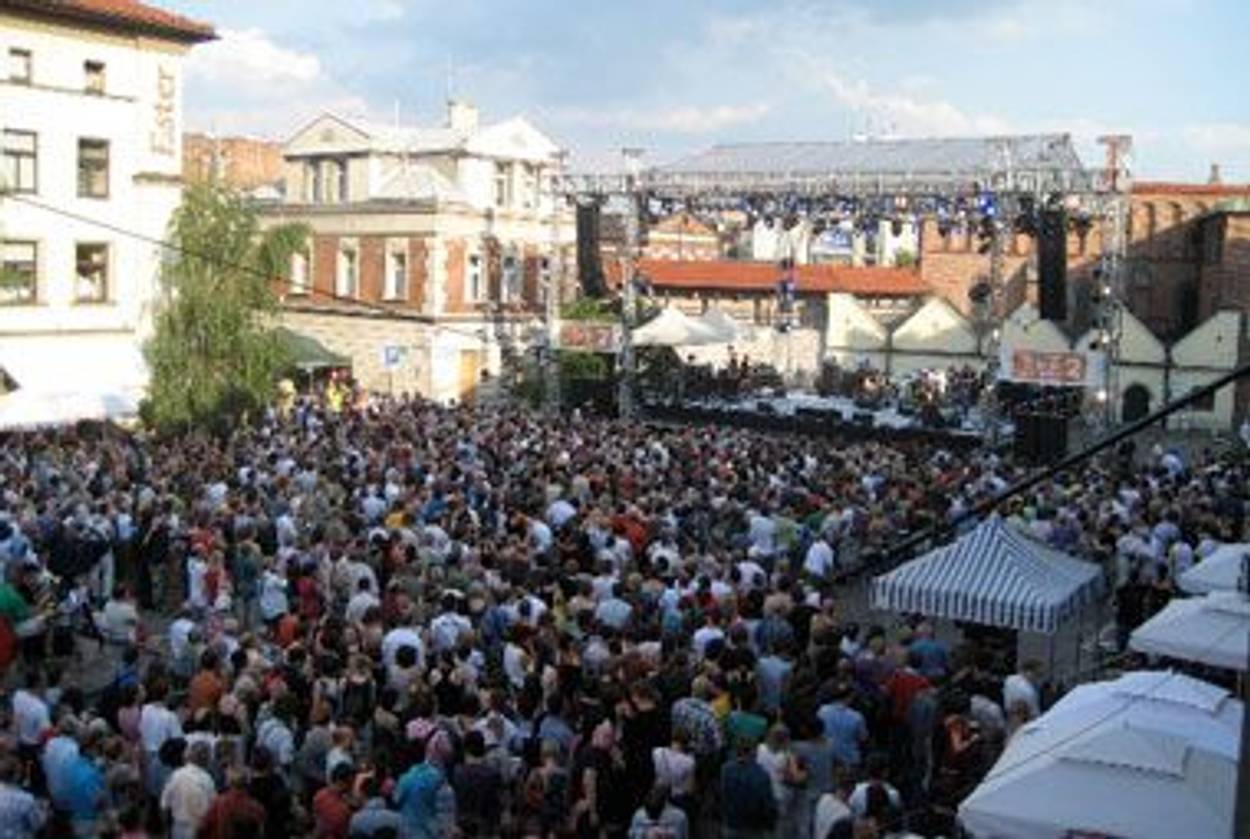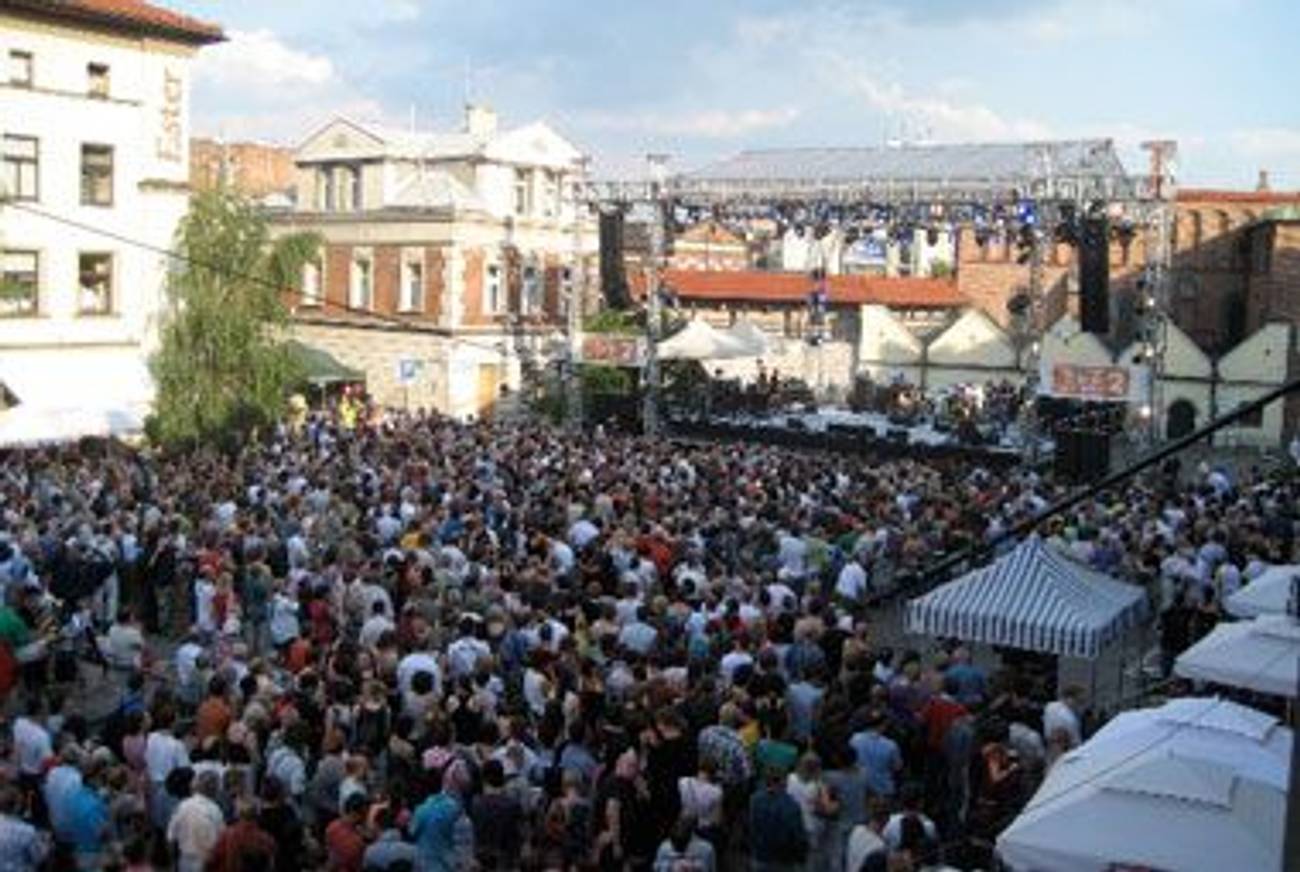The Mute Stones
Once bustling, and long silent, Krakow’s streets sing anew




In the first of Leonard Michaels’s “Nachman” stories, Nachman visits Poland, in search not of the death camp that erased his family, but of the ghetto where they once lived. He wanders into a deserted synagogue and imagines it full of davening Jews. He fantasizes that all the vacancy facing him will, in an instant, be overturned and the dead would come back to life, “the Jews would return and collect in this room.” There would be, in his prescient and painful words, “presence as opposed to history.”
Poland is fertile ground for a fantasy like Nachman’s. So much Jewish history, so little Jewish presence. The country is underpopulated by Jews and overpopulated with Jewish ghosts, towns and cities once shaped by Jewish life and culture now haunted by specters of a melancholic and brutal history that hover over trampled cemeteries and begrudging monuments, or as you find in Warsaw, a shimmering office building of mirrored glass built on the ground where the Great Synagogue once stood and the Chinese embassy that, many believe, sits on dirt where the final, undiscovered milk can of Emanuel Ringelblum’s Warsaw Ghetto documents is still buried.
In the early 1920s, Polish photographer Witold Chrominski took a panoramic shot of Szeroka Street, the central artery that leads into the main square of Krakow’s Jewish quarter, the Kazimierz. In the photo, the square is packed shoulder to shoulder with Jews, men in hats and long wool coats, women wrapped in shawls lugging stuffed shopping bags. It is a scene that bursts with life: you can hear the hum of conversations, the shuffling of weary feet, the shouts of vendors. Today, that same square bursts with a different kind of life and is mostly visited by tourists who’ve come to see the place that was once full of all of those Jews. It is a vibrant place these days, but when you stand in the middle of it and think of that photograph, the square’s enduring emptiness is stunning. The missing are everywhere. Instead of Jews, there are Jewish simulacra, walls covered with replicas of Jewish storefronts, kiosks selling wooden figurines of Orthodox Jews and Jewish violinists, “Jewish style” restaurants with names like Rubenstein and Babelstein, and Klezmer-Hois, a bohemian klezmer-themed cafe and hotel that sells old maps of Eastern Europe and vintage posters of Palestine and Israel. A restaurant that incredibly calls itself “Once Upon a Time in Kazimierz” advertises a trip “down memory lane” where you can eat your way back into a magical Polish past when Jews and Poles lived happily side by side. Under the seductive spell of selective post-Holocaust and post-Communist memory, Poland’s long, bitter history of anti-Semitism barely whispers its name in the sepia-toned shadows of vintage Judaica and colorful pre-Shoah nostalgia.
On our first day in Krakow—Roger Bennett, David Katznelson, Seymour Stein and I were in town for the annual Krakow Jewish Culture Festival—we were lucky enough to sit down in the garden of the Klezmer-Hois with Leopold Kozlowski, the iconic “last klezmer” of Poland and former musical director of the Jewish Theater in Warsaw who has preserved klezmer traditions from his pre-war days as a boy in the Ukraine through his post-war years as a Holocaust survivor. While Kozlowski spoke honestly of his ambivalence about the commercialization of Jewish memory in Krakow, he was also quick to emphasize just how important any shard of that memory still is to him. The Klezmer-Hois might not be an actual house for actual klezmers, but it’s still a place for him to sit in the breezy shade of trees, sip coffee, and pass on his songs and stories to new generations of Poles, Jewish and non-Jewish alike. Authenticity, he reminded us, is a complicated game in post-war Poland, and, at his age, knowing what he knows, a fake Jewish square can feel as real as anything else.
He told us that when he first came back to Krakow after the war he stood in the middle of the square and played his music for what he called the “mute stones” of Kazimierz. He wanted the stones to be reminded of the music they once knew, to ensure that memory would not fade into the silences of history.
The next day I visited Krakow’s Galicia Museum where an exhibition of paintings by Mayer Kirshenblatt, They Called Me Mayer July, was about to open. Among the work dedicated to memories of his Polish childhood in the ’20s is a painting of a “phonograph party,” in which a single phonograph blasts music from a living room window out to a town square full of people. When I spoke about the piece to the show’s curator—his daughter, the NYU professor Barbara Kirshenblatt-Gimblett, who is also directing the new Jewish museum being built in the Warsaw ghetto—she immediately unraveled more stories of Poland’s “mute stones.” Who talks of Poland’s own Tin Pan Alley from the interwar years when Polish Jews wrote pop and jazz tunes in Polish for national audiences? Who remembers the dashing Jewish star of Polish musicals, Warsaw’s own Adam Aston crooning songs like “Nikodem” and “Panie Janie”? Who remembers the tunes of Henryk Wars, the Polish Irving Berlin, who later reinvented himself as Henry Vars in Hollywood, where he composed the theme music to Flipper?
Since the 1980s, modern Poland has been working hard to grapple with its repressions of Holocaust memory and its often stubborn and cruel refusals to touch the scars of national witness. Cities like Warsaw and Krakow have become sites of intensive recovery and reconstruction efforts where once-forgotten names like Aston and Kozlowski, where the names of the thousands in Chrominski’s photograph, might receive some sort of memorial recognition as Jews, even if it’s only in tourist gift shops, cultural festivals, death camp tours, or on the walls of museums.
A key piece in this process has been the Krakow Jewish Culture Festival, mostly run by non-Jews for non-Jews, and which exists precisely to look memory in the face, to keep the stones from staying mute. The majority of this year’s performers came from the United States, where Jewish musical memory has long thrived alongside actual Jews, and historically the festival has, in a kind of reverse migration, imported Jewish music back into Poland. Which meant that familiar faces from the American scene like Frank London and Michael Alpert—leading New York lights of Jewish musical innovation and preservation—could play in Krakow’s only Reform synagogue on the same stage as both a crew of fellow New Yorkers (Sephardic-Mizrachi fusionists Pharoah’s Daughter, legendary Brooklyn cantor Benzion Miller, cantorial rock experimentalists The Sway Machinery) and The Other Europeans, a remarkable U.S.-Europe ensemble of Jewish and Gypsy musicians.
On the festival’s final night, Balkan Beat Box, the New York based band of Israeli brass devotees who manically meld Mediterranean and Gypsy styles through a hip-hop sensibility, commanded the coveted midnight slot. From the back of the Kazimierz square, you could barely see the stage. Well over 5,000 people had poured down Szeroka Street, dancing on cobblestones, cheering from balconies, and crowding restaurant tables. The square looked just like Chrominski’s old photo, packed and alive with people and culture not simulacra, only now the majority of the people were Poles who were not Jewish. Yet there they were, swept up in Jewish and Gypsy melodies, locked into the rhythms of history without presence, dancing with ghosts on top of mute stones.
Josh Kun is a co-founder of The Idelsohn Society for Musical Preservation and a professor in the Annenberg School for Communication at the University of Southern California. With Roger Bennett, he is co-author of And You Shall Know Us By The Trail Of Our Vinyl (Crown, 2008) and co-curator of Jews on Vinyl.